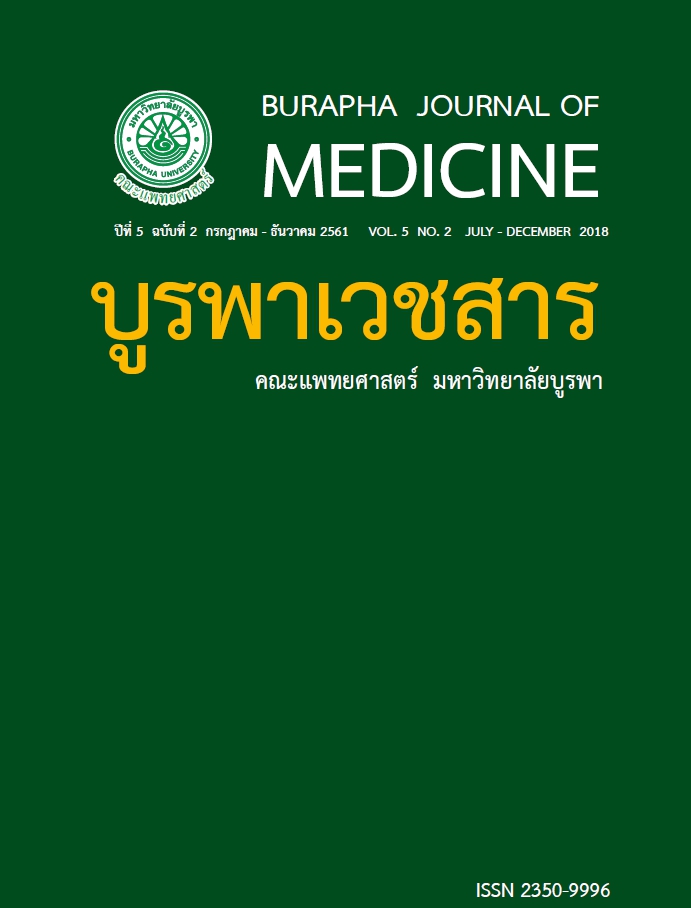การยอมรับและความพึงพอใจต่อตำรับอาหารลดหวานมันเค็ม
คำสำคัญ:
อาหาร, สุขภาพ, การทดสอบทางประสาทสัมผัส, โรคไม่ติดเชื้อเรื้อรังบทคัดย่อ
วัตถุประสงค์ เพื่อพัฒนาตำรับอาหารที่มีการลดพลังงานจากการดัดแปลงส่วนประกอบและเครื่องปรุงเพื่อให้ได้
ตำรับอาหารเพื่อสุขภาพสำหรับเป็นทางเลือกของคนทั่วไป
วิธีการศึกษา เมนูอาหาร 5 เมนู ได้แก่ ต้มข่าไก่ ผัดขี้เมาไก่ หมูผัดเปรี้ยวหวาน พะแนงไก่ และฉ่ฉู ี่ปลาได้รับเลือก
ให้นำมาใช้เป็นเมนูอาหารในการวิจัยครั้งนี้ โดยแต่ละเมนูแบ่งออกเป็น 2 สูตร คือ สูตรควบคุมที่เป็นสูตรต้นตำรับ
และสูตรดัดแปลงที่มีการลดพลังงานจากอาหารลง ทำการทดสอบความพึงพอใจทางประสาทสัมผัสในอาสาสมัคร
ที่มีสุขภาพดีทั้งเพศหญิงและชายจำนวน 30 คน
ผลการศึกษา พบว่าในเมนูต้มข่าไก่ ผัดขี้เมาไก่ และหมูผัดเปรี้ยวหวาน ไม่มีความแตกต่างกันของคะแนนเฉลี่ย
ความพึงพอใจในทุกด้านระหว่างสูตรควบคุมกับสูตรดัดแปลง ในขณะที่เมนูพะแนงไก่และฉู่ฉี่ปลามีคะแนน
เฉลี่ยความพึงพอใจทางประสาทสัมผัสของสูตรดัดแปลงมากกว่าสูตรควบคุม นอกจากนี้ คะแนนเฉลี่ยด้าน
ความพึงพอใจโดยภาพรวมของทุกเมนูอยู่ในเกณฑ์ที่บ่งชี้ว่าอาสาสมัครให้การยอมรับ
สรุป ตำหรับอาหารลดหวานมันเค็มที่พัฒนาขึ้นได้รับการยอมรับและพึงพอใจจากอาสาสมัคร
เอกสารอ้างอิง
SS. The evolving contribution of noncommunicable
diseases (NCDs) to
maternal mortality in Jamaica, 1998-2015:
a population based study. BJOG. 2018; doi:
10.1111/1471-0528.15154. (In Press).
2. Kankeu HT, Saksena P, Xu K, Evans DB. The
financial burden from non-communicable
diseases in low- and middle-income
countries: a literature review. Health Res
Policy Syst. 2013; 11: 31.
3. Divajeva D, Marsh T, Logstrup S, Kestens
M, Vemer P, Kriaucioniene V, Peresson S,
O’Kelly S, Rito S, Webber L. Economics
of chronic diseases protocol: costeffectiveness
modelling and the future
burden of non-communicable disease in
Europe. BMC Public Health. 2014; 14: 456.
4. Bhagyalaxmi A, Atul T, Shikha J. Prevalence
of risk factors of non-communicable
diseases in a district of Gujarat, India. J
Health Popul Nutr. 2013; 31: 78–85.
5. Naseem S, Khattak UK, Ghazanfar H, Irfan
A. Prevalence of non-communicable
diseases and their risk factors at a semiurban
community, Pakistan. Pan Afr Med
J. 2016; 23: 151.
6. Angkurawaranon C, Wattanatchariya
N, Doyle P, Nitsch D. Urbanization and
non-communicable disease mortality in
Thailand: an ecological correlation study.
Trop Med Int Health. 2013; 18: 130–40.
7. Rippe JM, Angelopoulos TJ. Relationship
between added Sugars consumption
and chronic disease risk factors: Current
understanding. Nutrients. 2016; 8: 697.
8. Chavasit V, Kriengsinyos W, Photi J, Tontisirin
K. Trends of increases in potential risk
factors and prevalence rates of diabetes
mellitus in Thailand. Eur J Clin Nutr. 2017;
71: 839-43.
9. Asghari G, Yuzbashian E, Mirmiran P,
Mahmoodi B, Azizi F. Fast food intake
increases the incidence of metabolic
syndrome in children and adolescents:
Tehran lipid and glucose study. PLoS One.
2015; 10: e0139641.
10. Ha SK. Dietary Salt Intake and Hypertension.
Electrolyte Blood Press. 2014; 12: 7–18.
11. Banwell C, Dixon J, Seubsman S, Pangsap
S, Kelly M, Sleigh A. Evolving food retail
environments in Thailand and implications
for the health and nutrition transition.
Public Health Nutr. 2013; 16: 608–15.
12. Ley SH, Hamdy O, Mohan V, Hu FB.
Prevention and management of type
2 diabetes: Dietary components and
nutritional strategies. Lancet. 2014;
383(9933): 1999–2007.
13. Horadakuna P, Lamsan J, Wittayacom
K, Singhato A. Daily sugar intake and
its relationship on body mass index
among Burapha University students. In
proceedings of the 6th Burapha University
International Conference 2017. 3-4 August,
2017; Holiday Inn, Pattaya: Burapha
University. p. 338-44.
14. Praditsathaporn C, Doungtip E, ITiin N,
Pinpu M, Wongkinee W. Traditional food
recipe in Phayao: Inheritance of local
wisdom and the nutritional value. Area
Based Development Research Journal.
2017; 9: 297-313.
15. J a n j a r o e n K , W a n n a w i l a i P ,
Chaiwongnakkapun C. The traditional
southern food: a treasure for health. The
Southern College Network Journal of
Nursing and Public Health. 2017; 4: 281-90.
16. Malinauskas BM, Aeby VG, Overton RF,
Carpenter-Aeby C, Barber-Heidal K. A
survey of energy drink consumption
patterns among college students. Nutr J.
2007; 6: 35.
17. Wichchukita S, O’Mahony M. The 9 -point
hedonic scale and hedonic ranking in
food science: some reappraisals and
alternatives. J Sci Food Agric. 2014; Doi
10.1002/jsfa.6993
18. Amerine MA, Pangborn RM, Roessler EB,
editdors. Principles of Sensory Evaluation
of Food. Academic Press: New York,
p. 367–374; 1965.
19. Kongpun S, Krayom P, editors. 80 recipes
of Thai traditional food. Sangdad Press:
Bangkok; 2013.
20. Singhato A, Banjong O, Charoonruk G.
Effectiveness and acceptance of the
developed educational media on the
application of a Thai ethnic snack, Thong
Pub, with calcium fortification. J Ethn
Foods. 2017; 4: 58-63.
21. Singh-Ackbarali D, Maharaj R. Sensory
evaluation as a tool in determining
acceptability of innovative products
developed by undergraduate students
in food science and technology at the
University of Trinidad and Tobago. Journal
of Curriculum and Teaching. 2014; 3: 10-
27.
22. Choi WH, Ahn J, Jung CH, Seo JS, lHa
TY. Korean diet prevents obesity and
ameliorates insulin resistance in mice fed a
high-fat diet. J Ethn Foods. 2017; 4: 36-43.
23. Karizaki VM. Ethnic and traditional Iranian
breads: different types, and historical and
cultural aspects. J Ethn Foods. 2017; 4:
8-14.
24. Eadmusik S, Puwastien P, Nitithamyong
A. Production of hard tofu from calcium
fortifi ed soybean milk and its chemical
and sensory properties. KKU Res J. 2013;
18: 371-9.
25. Seong PN, Seo HW, Kang SM, Kim YS, Cho
SH, Kim JH, Hoa VB. Beneficial Effects
of Traditional Seasonings on Quality
Characteristics of Fermented Sausages.
Asian-Australas J Anim Sci. 2016; 29:
1173–80.
26. Polsky S, Beck J, Stark RA, Pan Z, Hill
JO, Peters JC. The Influence of Herbs,
Spices, and Regular Sausage and Chicken
Consumption on Liking of Reduced Fat
Breakfast and Lunch Items. J Food Sci.
2014; 79: 2117–26.
27. Nethan S, Sinha D, Mehrotra R. Non
Communicable Disease Risk Factors and
their Trends in India. Asian Pac J Cancer
Prev. 2017; 18: 2005–10.
28. Soeliman FA, Azadbakht L. Weight loss
maintenance: A review on dietary related
strategies. J Res Med Sci. 2014; 19: 268–75.
29. Ha SK. Dietary Salt Intake and Hypertension.
Electrolyte Blood Press. 2014; 12: 7–18.
30. Korgaonkar S, Tilea A, Gillespie BW, Kiser
M, Eisele G, Finkelstein F, Kotanko P, Pitt B,
Saran R. Serum Potassium and Outcomes
in CKD: Insights from the RRI-CKD Cohort
Study. Clin J Am Soc Nephrol. 2010; 5:
762–9.



